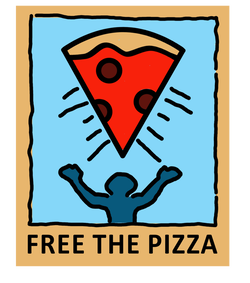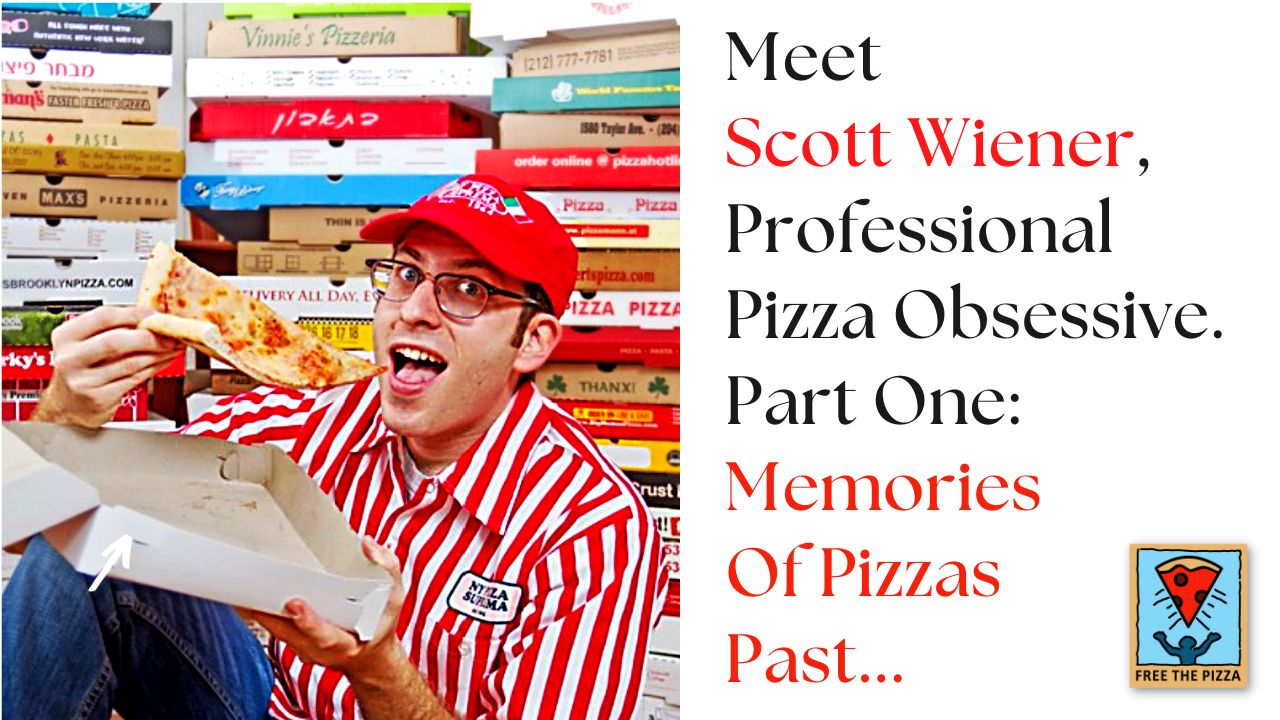|
Is it possible to make a career out of simply loving pizza? Scott Wiener may come closer to having that life than anyone. Scott had planned on being a music producer for film and TV. But the universe had other ideas, and he embraced them. He now has a business in New York called Scott’s Pizza Tours. Founded in 2008, they run “New York City Pizza Tours For True Pizza Nerds.” They offer walking tours, a bus tour, private tours, and also have online pizza classes. Scott has also appeared in the New Haven pizza documentary called Pizza: A Love Story, he’s the subject of another documentary called (oddly enough) Scott’s Pizza Tours. And if you watch Hulu, you may have seen him as a competitor on the pizza-making competition series called Best In Dough. He also has a book about the art of the pizza box, Viva La Pizza. Perhaps Scott’s most significant role is as the founder of the 501(c)(3), Slice Out Hunger. Their mission is producing “pizza-related events and campaigns to fight food insecurity across the U.S.”
Scott also has the world’s largest collection of pizza boxes, verified by Guinness World Records. To borrow from Scott’s bio on his tour website, he has successfully turned an obsession into a lifestyle. I sat down with Scott to talk pizza, and it was a long, sprawling conversation covering many aspects of pizza. After we were done, I knew it would be necessary to break this interview up into parts. The first part, excerpted here, is about the potency of pizza memories. (If you have a strong pizza memory, you’re invited to be part of a project related to the power of those food memories for a book project.) Here now, Part 1 of my interview with Scott Wiener of Scott’s Pizza Tours. BLAINE: Scott, thanks for playing. I ask this first question to everybody we interview. What is your favorite pizza memory? You've probably got a few. SCOTT: Well, the thing is, with this kind of question, you can't think too much. It has to be whatever comes right into the brain. And there are three memories that come to the brain immediately, chronologically. The first one is the sitting in Pizza Hut on a Tuesday night and getting the personal pan pizza because I read five books that month, and getting a little coupon for the free pizza, and owning just what a celebration that was because you earn it. It’s the Book It! program that Pizza Hut still does like 30 years later. The book program incentivizes reading by giving you a small pizza as long as your parents buy another pizza, only on a Tuesday night. It's a brilliant marketing scheme that I now realize what it really was, which is fine. BLAINE: The slowest night of the week. SCOTT: Yeah, it makes me like them even more, but that is a great memory, just being in the Pizza Hut, sitting down in a booth, 1993, something like that. That's memory number one. Then next, chronologically, is walking home from middle school on a half day, like a Friday that was a half day, and using my own money to buy a slice and a soda for a buck 50. And then if I had an extra quarter around, get a gumball or a bouncy ball or something. The feeling of independence of purchasing that pizza was amazing. But then, pizza was just sort of a food that was associated with good times until my third big pizza moment. It was the first time we went to [the famous pizzeria] DiFara in Brooklyn, which is notoriously slow and packed and busy. And I remember, elbow to elbow, it was the dead of winter, and the room was so steamy though. You were sweating. The person next to me, this tall dude, he looks down at me and he's like, “I see this look in your face. I know it’s your first time here. And I would trade every slice that I've ever had here since 1971 to be you right now, having my first slice.” That's that moment. I remember not eating the pizza, but having a connection with another customer who was so excited at my excitement to be there. That's a cosmic—I don't know, I never met the guy in my life—a cosmic moment. BLAINE: That's fantastic. I love that. Okay, we're going to go down a rabbit hole here for a second. Are you familiar with the idea of Proust’s Madeline? SCOTT: No. BLAINE: You know who Marcel Proust was? SCOTT: Yes. BLAINE: And you've never read him because none of us do. SCOTT: No, never BLAINE: The book that people probably know him for is In Search Of Lost Time, also known previously as Remembrance Of Things Past. And I've never read it either, just so you know. But Proust’s Madeline is a literary metaphor from this book. The protagonist is eating a Madeleine that has been dipped in tea. Suddenly, he has a long forgotten memory of being a kid in his family home and being fed a piece of a Madeline that's been dipped in tea by his invalid aunt. And now, it's kind of a thing. If there's something, a taste or something that inspires a long lost memory, it's referred to as Proust’s Madeline. And I thought, instead of a madeleine, what if Proust had pizza? So, for you, is there a pizza that takes you rushing back to someplace? If you walk into a Pizza Hut, are you suddenly that kid again on a Tuesday night? Or is there any pizza that takes you back to that time at DiFara’s? SCOTT: The issue here is that a lot of the pizza that really was formative for me has changed. And now, revisiting it, it's not the same. And it damages the memory. And now the amount that I liked it before, I now dislike it that amount. So if there's anything that brings me back to that memory, it is going to be an anonymous pizzeria in the suburbs of North Jersey. It's not a specific place, but there is a smell and a flavor profile that's really from their sauce. And I can't even put my finger on what it is. And I've tried. I've been like, what product is that? Are they all just buying Stanislaus Full Red? And that's my taste memory, but it's not. And I can never put my finger on it, but sometimes I'll have it, and as I eat it, I'm thinking, This is not technically good, but it pulls me back to the taste, which is so hard now. I eat pizza on a more technical level, and it's sometimes hard to have the sloppy slice, but still there's that note on the nose. I don't have a specific one. But I know it when I taste it. BLAINE: I know exactly what you're talking about. There's a note for me and I'm not really sure what it is. It might be oregano blended with another herb, but I take a bite and immediately I am in Grand Central Station at the old Caruso's Pizza counter, getting a slice five minutes before my train leaves. And it's the last one out of Grand Central that night at 10:37. And I loved that pizza. And I don't know if it was because of the time and the place and the people involved, or if it really was that good. I don't think it was that good. I think it was good serviceable New York street pizza. SCOTT: Because it doesn't matter if the slice was any good, what matters is that it meant something in that moment. The technical quality is irrelevant. It's secondary. BLAINE: I've asked more people about this and I'm surprised at how many people have a big chain store memory. A Vietnamese friend in Miami who's a chef grew up in a Vietnamese family and pizza wasn't a thing. He remembers distinctly when he was six years old, and he went on a field trip from school to the Domino's Pizza up the block, and it was his first experience with pizza. And they made pizza, they ate pizza, and the memory is cemented in there. And now, anytime he goes into a Domino's, he’s six years old and back in that first Domino's. SCOTT: It's what you grew up with, that’s what's formative. What you're eating when you're 12. If you're eating it when you're 12, they getcha. This has been Part One. Several more parts will be featured in the coming weeks. Big thanks to Scott Wiener for his willingness to play. If you’d like to know more about Scott’s Pizza Tours, click here. If you’re curious to know more about pizza boxes, check out Scott’s book, Viva La Pizza, right here. If you’re interested in learning more about having pizza parties to #RaiseMoreDough for hunger relief across the country, visit Slice Out Hunger’s website here. If you’d like to know more about sharing your pizza memory with the book project, Pizza Memories, click here.
0 Comments
Leave a Reply. |
AuthorBlaine Parker is the award-winning author of the bestselling, unusual and amusing how-to pizza book, Free The Pizza. Also known as The Pizza Geek and "Hey, Pizza Man!", Blaine is fanatical about the idea that true, pro-quality pizza can be made at home. His home. Your home. Anyone's home. After 20 years of honing his craft and making pizza in standard consumer ovens across the nation, he's sharing what he's learned with home cooks like you. Are you ready to pizza? Archives
July 2024
Categories
All
|
© Copyright 2021, 2022, 2023, 2024. All rights reserved.
As a ShareASale Affiliate and an Amazon Associate, we earn a small percentage from qualifying Amazon purchases at no additional cost to you.
When you click those links to Amazon (and a few other sites we work with), and you buy something, you are helping this website stay afloat, and you're helping us have many more glorious photographs of impressive pizza.
When you click those links to Amazon (and a few other sites we work with), and you buy something, you are helping this website stay afloat, and you're helping us have many more glorious photographs of impressive pizza.


 RSS Feed
RSS Feed